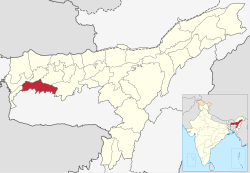Goalpara district | |
|---|---|
 Shiva temple at Sri Surya Pahar | |
| Nickname: Raghunath | |
 Location in Assam | |
| Country | |
| State | Assam |
| Division | Lower Assam |
| Established | 20 October 1994 |
| Headquarters | Goalpara |
| Government | |
| • Lok Sabha constituencies | Dhubri (shared with South Salmara-Mankachar District, Dhubri district) |
| • Vidhan Sabha constituencies | Dudhnai, Goalpara East, Goalpara West, Jaleswar |
| Area | |
• Total | 1,824 km2 (704 sq mi) |
| Population (2011) | |
• Total | 1,008,183 |
| • Density | 552.7/km2 (1,432/sq mi) |
| Demonym | Goalpariya |
| Languages | |
| • Official | Assamese |
| Time zone | UTC+5:30 (IST) |
| PIN | 783 101 to** (** area code) |
| Telephone code | 03663 |
| ISO 3166 code | IN-AS, IN-AS-GP |
| Vehicle registration | AS 18 |
| Website | goalpara |
Goalpara district is an administrative district of the Indian state of Assam.
